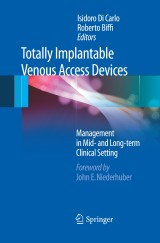Details

Totally Implantable Venous Access Devices
|
106,99 € |
|
| Verlag: | Springer |
| Format: | |
| Veröffentl.: | 01.02.2012 |
| ISBN/EAN: | 9788847023734 |
| Sprache: | englisch |
| Anzahl Seiten: | 286 |
Dieses eBook enthält ein Wasserzeichen.
Beschreibungen
<p>Since their first application in 1982, Totally Implantable Venous Access Devices (TIVADs) have become increasingly important in the clinical practice, as more intensive chemotherapy and parenteral treatments have come into use. At this time, there is objective evidence that TIVADs are a safe, effective strategy for long-term venous access; they play a significant role throughout the management of the oncology patient, as they are needed in the initial phases for active treatments as well as in the last stages for palliative measures, making possible repeated administration of chemotherapeutic vesicant agents, nutrients, antibiotics, analgesics, and blood products. According to a number of prospective studies, use of TIVADs is associated with a significant complication rate (10% to 25% of all patients). Evidence-based data support that most complications are directly related to inappropriate technique of placement and/or nursing care, sometimes leading to TIVAD loss, significant morbidity, increased duration of hospitalization, and additional medical cost. </p><p>A group of world-renowned experts - both in the clinical and research fields – contributed to this volume, whose aim is to provide clinicians, nurses and medical students with a multidisciplinary, full update on these devices, as long term central venous access can no be longer considered a routine matter, and serious complications can be maintained at a very low level only if strict adherence to a well-defined protocol of surgical technique and of catheter care is maintained.</p>
<p><p>Part I Introduction.- History of Vascular Access.- Vascular Anatomy of Central and Peripheral Veins.- Type of Devices for Mid- and Long-term Venous Access.- Huber Needle: Different Types, Uses, Prevention of Accidents.- Part II Totally Implantable Access Devices.- Clinical Indications, Preoperative Assessment, Set-up and Organizational Aspects.- Choice of Venous Sites. Surgical Implant/Technique.- Choice of Venous Sites. Percutaneous Implant/Technique/US Guidance.- Modified Seldinger Technique for Open Central Venous Cannulation for Totally Implantable Access Device.- Optimal Catheter Tip Position: Radiologic Criteria and Clinical Relevance.- Verifying Catheter Tip Position: Fluoroscopy vs Intravasal Electrogram.- Part III Immediate Complication: Prevention and Treatment.- Pneumothorax.-Hemothorax.- Air Embolism.- Accidental Arterial Puncture.- Cardiac Arrhythmia.- Heart Tamponade.- Brachial Plexus Injury.- Part IV Early Complications: Diagnosis and Treatment.- Hemoptysis.- Pocket Hematoma.- Wound Dehiscence.- Reversal.- Part V Late Complications.- Catheter-related Bloodstream Infection.-Thrombosis.- Superior Vena Cava Erosion and Perforation.-Catheter Obstruction.- Catheter Rupture.- Catheter Migration.- Catheter Embolization.- Withdrawal Obstruction.-Skin Necrosis.- Extravasation.- Pocket Infection.- Nursing of Vascular Access: Highlights of Hot Issues.- Power Technology: How to Safely Use Ports and Central Catheters to Deliver Contrast Medium in Radiology Procedures.- Removal of Totally ImplantableVenous Access Device.- Cost Issues.- Quality of Life and Patients Satisfaction.- Legal Aspects.- Future Investigation. </p><p><p>
<p>Since their first application in 1982, Totally Implantable Venous Access Devices (TIVADs) have become increasingly important in the clinical practice, as more intensive chemotherapy and parenteral treatments have come into use. At this time, there is objective evidence that TIVADs are a safe, effective strategy for long-term venous access; they play a significant role throughout the management of the oncology patient, as they are needed in the initial phases for active treatments as well as in the last stages for palliative measures, making possible repeated administration of chemotherapeutic vesicant agents, nutrients, antibiotics, analgesics, and blood products. According to a number of prospective studies, use of TIVADs is associated with a significant complication rate (10% to 25% of all patients). Evidence-based data support that most complications are directly related to inappropriate technique of placement and/or nursing care, sometimes leading to TIVAD loss, significant morbidity, increased duration of hospitalization, and additional medical cost. </p><p>A group of world-renowned experts - both in the clinical and research fields – contributed to this volume, whose aim is to provide clinicians, nurses and medical students with a multidisciplinary, full update on these devices, as long term central venous access can no be longer considered a routine matter, and serious complications can be maintained at a very low level only if strict adherence to a well-defined protocol of surgical technique and of catheter care is maintained.</p>
This volume is an update on the evolution of the indications for implantation and the associated increases in complications and costs The book will be helpful for all the specialists involved in this field Also for students and nurses
Diese Produkte könnten Sie auch interessieren:

La interacción del neonato: un instrumento de evaluación observacional, CITMI-NB

von: Rosa María Trenado Santarén, M. Ángeles Cerezo Jiménez, Tayomara Ferreira Nascimento

10,99 €

Enfermedades infecciosas en la unidad de terapia intensiva

von: Raúl Carrillo Esper, Raúl Carrillo Editorial Alfil, S. A. de C. V.

32,99 €















